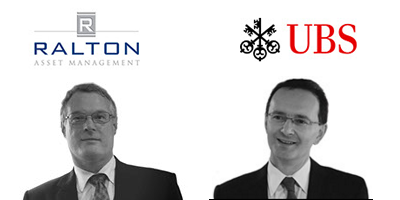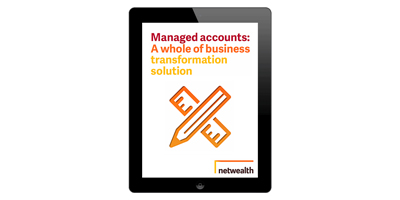Managed accounts have figured significantly in US market for some decades. Indeed, recent research from Cerulli, one of the longest-running managed accounts researchers, estimates the sector in the US market will grow to US$6.7 trillion in assets under management by 20171.
Access to managed accounts in Australia, however, was traditionally limited to high-net worth individuals through niche providers and a select number of financial advisers. Advances in technology have changed all that, and investment and superannuation companies including Netwealth are now offering managed accounts to more advisers and investors.
In fact, the rising demand domestically is difficult to ignore, especially considering how infrequently managed accounts were discussed (and used) just 10 years ago. Morgan Stanley in its ASIA Insight (June 22, 2016) forecast FUA (funds under administration) in managed accounts in Australia to reach A$60 billion in 2020 based on a number of factors including the fact that they are better at meeting customer needs.
Managed accounts come in many forms and are promoted under a variety of names which typically reflect the legal structure they are governed by. The most common structures include Separately Managed Accounts (SMAs) or Individually Managed Accounts (IMAs). Throughout the article we will refer to all structures simply as managed accounts.
Much of the discourse around managed accounts focuses on their utility as an investment product. They are frequently compared to managed funds, and the conversation tilts towards describing products that are similar to traditional managed funds, but with greater transparency and direct or beneficial ownership of underlying assets - a portfolio of Australian equities, for example, but where the investor is an owner rather than a unitholder.
While managed accounts can be viewed this way, it's worth exploring how their broader utility can increase back-office efficiency in advice businesses, enable better scalability and drive much higher levels of client engagement than more traditional approaches.
Enhancing the client experience
A managed account gives an investor the ability to invest into one or more professionally managed investment models which are then actively reviewed and rebalanced based on the decisions of the chosen investment manager.
Investment models may comprise of domestic equities, exchange traded funds (ETFs), managed funds, international equities or a combination of asset types. Typically, these investment models reflect the investment themes, strategies, skills and experiences of the investment manager.
Managed accounts and investment models are normally available to investors and advisers through superannuation and investment platforms, like Netwealth.
Typically, a managed account (and its investment models) can sit alongside other super or non-super investments so they can be monitored, reported and reviewed in a single online environment.
The benefits to your clients
The legal and ownership structure of a managed account creates a number of important benefits for the investor:
- They can see exactly where their money is invested and what assets have been bought and sold on their behalf.
- They can see the performance of specific assets which make up the portfolio and how each asset contributes to investment performance.
- They are able to set investment parameters and rules around how their portfolio is implemented, including investment exclusions and substitutions, minimum trade and holding size (for example, an investor can choose to substitute Rio Tinto Limited for BHP Billiton Ltd or lock in, lock out or exclude specific stocks from their portfolio).
- They get the full benefit of any franking credits.
- They do not buy into any embedded tax liability which can be the case if they are invested in a managed fund.
The general differences between managed accounts, managed funds and investing directly in shares.

A whole of business solution
Tidying the back office
In Australia conversations around managed accounts still focus on their utility as an investment product. But it's worth exploring how their broader utility can also increase back-office efficiency.
Within a managed account structure advisers can provide clients with access to a diversified range of assets, including access to international equities. Advisers can integrate and blend any number of different models to suit a client’s diversification needs and risk appetite without many of the traditional administration headaches associated with monitoring and updating the portfolio over time.
Managed accounts as a portfolio management tool can offer a more consistent and systematised approach.
As a small business operator, if you are looking to continue to charge the same fees, to the same customer, for the same services that are being offered by automated systems, then you may find that technology will erode your customer base and profits.
The benefits of a managed account to advisers and dealer groups include:
- Investment decisions on portfolios by the model's investment manager are implemented across all clients, without the need for individual ROAs or SOAs, saving implementation leakage as well as significant work by the adviser
- Investment via the managed account can be tailored to better meet an adviser or their client’s requirements
- New clients can be easily allocated to an existing model or mix of models and implementation is efficient and timely
- The model manager makes and directs the implementation of most corporate action decisions on time and within the model portfolio's stated aims.
Two sides of the managed accounts discussion
One of the benefits of managed accounts is that it changes the dialogue you can have with your client. Not only can you discuss their investment portfolio at a strategy or holistic level by focusing on asset class or investment types; you now are able to have a detailed discussion with your client about the individual investments which make up the managed account model.
The magic ingredient: rebalancing
Whether an investor or adviser wishes to use models that may contain direct equities, hybrids, ETFs or managed funds, a managed account can provide a highly efficient investment solution which benefits the investor and the adviser delivering value all-round.
The act of rebalancing is one of the driving reasons for this.
Rebalancing is when the investment manager chooses to change allocations to assets in the model portfolio, providing instructions to the managed account provider (e.g. Netwealth) to buy or sell those assets. Those model portfolio trades are referenced against each client’s preferences and implemented for each investor who holds that model.
Rebalancing is the process that implements all necessary trades across all assets the adviser’s clients or investors hold in that investment model. A rebalance will take into account the investment preferences that may be specified by the investor or the adviser (on behalf of their clients).
These investment preferences may include, for example, minimum trade size, minimum holding size, as well as individual exceptions such as excluding particular assets from purchase or sale.
Rebalancing managed accounts is a simple two-step process:
- Investment manager notifies changes to the model
- Platform or managed account provider rebalances all clients taking into account investment preferences.
The benefit of this process for the adviser and investors is that investment models and underlying assets are constantly monitored by the investment manager and changes are implemented as and when appropriate. All investment portfolios are updated by the managed account provider without the need for investor or client authorisation. For advisers, this saves considerable administration and for investors it saves delays in implementation.
The benefits of the managed account become even more evident when wanting to combine multiple investment models or when using models with a large number of underlying assets which need to be rebalanced regularly.
Need more information? Call us on 1800 888 223 or email us to talk to a BDM.
Disclaimer
This information has been prepared and issued by Netwealth Investments Limited (Netwealth), ABN 85 090 569 109, AFSL 230975, ARSN 604 930 252. It contains factual information and general financial product advice only and has been prepared without taking into account your individual objectives, financial situation or needs. The information provided is not intended to be a substitute for professional financial product advice and you should determine its appropriateness having regard to your particular circumstances. The relevant disclosure document should be obtained from Netwealth and considered before deciding whether to acquire, dispose of, or to continue to hold, an investment in any Netwealth product. While all care has been taken in the preparation of this information (using sources believed to be reliable and accurate), no person, including Netwealth, or any other member of the Netwealth group of companies, accepts responsibility for any loss suffered by any person arising from reliance on this information.
We recommend the following resources

The different flavours of managed accounts
When setting out to establish a managed account solution for your business, you need to be aware that there are different business models that managed accounts can support. Find out the pros and cons of these offerings. Read article >

Industry leaders explore the benefits of managed accounts
Discover why these wealth management industry leaders are all advocates of managed account solutions. Watch videos >
